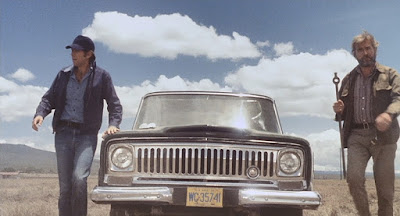(1974) Directed by Saul Bass; Written by Mayo Simon; Starring: Nigel Davenport, Michael Murphy and Lynne Frederick; Available on Blu-ray and DVD
Rating: ****
Note: This article is an expanded version of a capsule review, originally posted in November 2014.
“They’re not individuals. They’re individual cells. Tiny, functioning parts of the whole. Think of the society, James, with perfect harmony, perfect altruism and self-sacrifice, perfect division of labor organized for preordained roles. Think of the building of elaborate, complex structures according to plans they know nothing of, and execute perfectly. Think of their ability to evolve and adapt in ways that are so beautiful and still so unknown. And all contained in one simple form. So defenseless in the individual, so powerful in the mass.” – Dr. Ernest Hubbs (Nigel Davenport)
For the bulk of recorded history, humankind has been complacent about our position in the grand scheme of things, confident in the assumption that we are the dominant life form on Earth. But what if another creature, unassuming in its diminutive size, was poised to usurp our throne? Saul Bass’ cerebral science fiction film, Phase IV asks us to reconsider how we rate in the universe, compared to the ants.* Bass, best known for creating the memorable title sequences for many classic films (including Psycho and West Side Story), made his one and only outing as a feature film director with this movie.
* Fun Fact #1: Need further proof? The total population of ants is estimated to number 1 quadrillion, and the largest colony (consisting of Argentine ants) occupies a 3,700-mile stretch of land along the Mediterranean.
The opening narration informs us that unspecified “events in space” have upset the balance of life on Earth, leading to a profound shift in ant behavior. Cut to an abandoned housing project in the arid Arizona desert,* where the resident ants have successfully supplanted the human population. The desolate landscape sets the stage for a research project to observe the insects and their activities. An entomologist and his assistant, a statistician, collaborate to determine what the ants are planning. While the humans scratch their heads, they remain under the ever-watchful eyes of the colonial insects, perched within their unfathomable, monolithic towers.
* Fun Fact #2: Many of the sequences in the “Arizona” desert
were actually filmed in Kenya.
The three primary characters represent a rough, albeit
imperfect cross-section of society. Lead
researcher Dr. Ernest Hubbs (Nigel Davenport)* parallels the ants in his
single-minded pursuit of information, suspending emotion and compassion in
favor of logic. His callous demeanor provides a stark contrast to the more
balanced approach from his younger colleague, James Lesko (Michael Murphy).
Lesko regards deciphering the ants’ patterns as a sort of game. Unlike Hubbs,
however, he retains perspective about the stakes that are being played, as well
as the human cost. In a scene when their compound is under siege, Hubbs resorts
to releasing a powerful toxin against the ants. While fleeing their farm, a farmer
and his wife (Alan Gifford and Helen Horton)** are caught in the crossfire, succumbing
to the poison. Despite the fact that the pesticide caused their deaths, he’s
more concerned with the ingenuity of the ants, as opposed to their lifeless bodies
outside. After they rescue the couple’s teenage daughter Kendra Eldridge (Lynne
Frederick)***, Lesko is ready to pull the plug on the project, but Hubbs is opposed
to anything that would compromise his research. Compared to the two scientists,
Kendra is an innocent, caught in the middle. Although she seems the most likely
target for the ants and their abstruse schemes, all of them are being manipulated
in oddly unique ways.
* Fun Fact #3: According to the DVD commentary, Davenport read for the part of HAL 9000 in 2001: A Space Odyssey.
** Fun Fact #4: And while we’re on the subject of wayward artificial intelligence, Helen Horton, who appears briefly as Kendra’s grandmother, later provided the voice for the computer, MU-TH-UR 6000 (aka: “Mother”), in Alien (1979).
*** Fun Fact #5: Per the DVD commentary, Linda Blair was once
considered for the part of Kendra.
Phase IV effectively depicts the hidden world of the
ants and their society, providing a glimpse of an intelligence we can scarcely
comprehend. The massive colony operates as a massive solitary organism,
singular in its purpose, with every member committed to its goals, unfettered
by emotion or mercy. While the pesticide released by Hubbs seemingly stops the
colony dead in its tracks, it only proves to be a temporary setback. In one
scene, the worker ants slowly and methodically move the deadly yellow congealed
poison. They execute their plan little by little, with cold, unrelenting
precision and the end goal continually in mind. Individual deaths don’t matter
in the grand scheme of things, only the survival of the colony. The design of
the desert research facility itself mimics the twisty chambers of the ants’
lair, with the scientists navigating the labyrinthine rows of equipment.
Few would dispute that Phase IV’s claim to fame is
its stunning, immersive macrophotography by Ken Middleham (who previously
worked on the 1971 pseudo-documentary, The Hellstrom Chronicle), affording
viewers an unprecedented insect’s eye view. The ants scurry about in their tunnels,
revealing a place as alien as anything our minds could imagine. The filmmakers never
make the claim that no insects (or arachnids) were harmed in the making of this
picture, as Phase IV unflinchingly illustrates the often brutal, merciless
aspects of the ants’ lives. Dick Bush’s cinematography expertly complements
Middleham’s images, with an emphasis on shapes and symmetry. In the film’s opening
shot, what appears to be a field of stars pans out to reveal grains of sand.
The shot gradually transitions to space, suggesting there are worlds within
worlds. In another scene, the camera lingers on the enigmatic towers created by
the ants, the angular tops turned toward the sky, in a crude mimicry of human
faces. One of the film’s most disturbing images shows ants crawling out of a
hand (also used in the film’s poster art) recalling a similar shot from the
surrealist film, Un Chien Andalou (1929), by Luis Buñuel and Salvador
Dalí.
As a result of studio meddling, Saul Bass’ original, dystopian-flavored ending was scrapped in favor of a shorter, more ambiguous conclusion. The hallucinatory sequence, once thought lost, can now be found on the UK Blu-ray from 101 Films, providing an interesting alternate, if not necessarily better, conclusion to the story. With or without the original ending, Phase IV remains a thoughtful exploration of a mystery. In the best tradition of 1970s cinema, the film raises more questions than it answers, reveling in its ambiguity, and unabashed in its downbeat implications. But what’s pessimistic for humankind is optimistic for ant society (Are the ants ushering in a new stage of human evolution, or are we simply a vehicle for the ants’ evolution?). It’s a science fiction movie that trusts the intelligence of the audience to fill in the blanks. Phase IV suggests that we don’t have all the answers, and success, as well as failure, is a necessary part of science.
Sources for this article: 101 Films Blu-ray commentary by Allan Bryce and Richard Hollis; Ants.com; BBC Earth News, “Ant Mega-Colony Takes Over World,” by Matt Walker









Great review, Barry!
ReplyDeleteI haven't seen Phase IV in years, so I really should visit it again sometime.
By the way, your fun fact #1 should scare the #2 out of people! 😉
Thanks, John! It's well worth a second look. Oh, and the deleted original ending (at least part of it) is available on YouTube.
DeleteAs much as I admire and respect the ants, I agree with you about that first fact. I can't wrap my brain around that kind of number!
Excellent article about a truly scary science fiction film. The lack of humanity exhibited by Hubbs after killing Kendra's grandparents always shocks me.
ReplyDeleteThank you very much. I agree with you about Hubbs. A truly chilling scene.
DeleteSupposedly Bass cut the ending himself after getting no response to his letter to Kubrick. But his cutting is analogous to cutting 2001's last image. It is, after all, the Phase IV of the title. Bass never directed another feature.
ReplyDelete